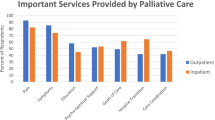Abstract
This prospective study of consecutive patients describes the palliative medicine consult service in a tertiary level cancer center and its impact on patient care. All inpatients/outpatients referred to the Palliative Medicine Program in a 4-month period were enrolled. Data were collected at the initial consultation using standardized forms with spaces for: reason for the consultation, referring service, demographics and history, ECOG performance status, symptoms, prognosis and diagnostic tests, treatment, and care plan. In all, 240 patients were seen: 79% were referred for symptom management; 53% were referred from medical oncology; and 50% were women. Median patient age was 67 years (range 18–96). Median performance status was 2 (1–4). Most (84%) of the patients had cancer. The cancer sites were: lung in 26% of cases, colorectal in 8%, and breast in 7%. Inpatients accounted for 53% and outpatients, for 47% of the study population. The median number of symptoms per patient was 13 (2–30). The estimated survival was <2 weeks in 15%, 2–8 weeks in 38%, 2–6 months in 37%, and >6 months in 10%. The patients' goals were: improve symptoms for 84%, return home for 55%, and no further admissions for 5%. The support systems named by patients were: family in 89%, friends in 13%, and the community in 5%. Hospice care was discussed at the consultation with 38% of the patients, would have been inappropriate for 31%, was not discussed with 22%, and had been discussed before with 9%. In response to questions about psychosocial care, a caregiver was identified by 78%, a spokesperson by 75%, and durable power of attorney was referred to by 21%. The DNR status was discussed on consult by 57%, had already been discussed with 30%, and was not discussed with 13%. Plan of care foresaw outpatient follow-up for 40%, inpatient follow-up for 32%, and transfer to palliative medicine for 27%. In 39% of cases the consults were considered late referrals. New medications suggested were opioids for 46% of patients, antiemetics for 28%, a bowel regimen for 24%, steroids for 15%, and others for 51%. (1) Palliative medicine consultation involves common complex medical, psychological, and social problems. (2) Complex symptomatology in this population is confirmed. (3) Multiple interventions were suggested even at the initial consultation. (4) Important issues such as DNR (do not resuscitate) status, support system, treatment goals, and eligibility for hospice care had often not been addressed.
Similar content being viewed by others
Author information
Authors and Affiliations
Additional information
Electronic Publication
Rights and permissions
About this article
Cite this article
Homsi, J., Walsh, D., Nelson, K.A. et al. The impact of a palliative medicine consultation service in medical oncology. Support Care Cancer 10, 337–342 (2002). https://doi.org/10.1007/s00520-002-0341-8
Published:
Issue Date:
DOI: https://doi.org/10.1007/s00520-002-0341-8




